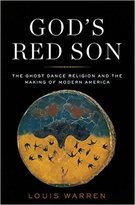Recommended Reading

Louis S. Warren’s God’s Red Son: The Ghost Dance Religion and the Making of Modern America,
2017, Basic Books.
The received idea of the Ghost Dance is that it marked the end of the Indian culture’s viability, in the massacre at Wounded Knee in 1890 in South Dakota. While something was brutally crushed there, something else survived in many forms. The Ghost Dance was misunderstood at the time as being a danger, when its prophet, Wovoka, told Native Americans they must accept the new world. Yet he also told them to keep dancing. The survival of the culture itself was perceived as a threat, and like Sitting Bull, had to be eliminated. (Sitting Bull was killed by Indian Police, the new authorities following US agent orders, though he had turned in his rifle years before).
2017, Basic Books.
The received idea of the Ghost Dance is that it marked the end of the Indian culture’s viability, in the massacre at Wounded Knee in 1890 in South Dakota. While something was brutally crushed there, something else survived in many forms. The Ghost Dance was misunderstood at the time as being a danger, when its prophet, Wovoka, told Native Americans they must accept the new world. Yet he also told them to keep dancing. The survival of the culture itself was perceived as a threat, and like Sitting Bull, had to be eliminated. (Sitting Bull was killed by Indian Police, the new authorities following US agent orders, though he had turned in his rifle years before).
The Native Americans saw Christian denominations of various kinds come to their reservations and try to win their faith, and that they were different from each other. They incorporated many aspects of Christian religion and referred to their dancing as going to church. Lewis points out that at this time various evangelical religious movements were not dissimilar to the Ghost Dancing, including Shakers, and many groups experiencing trance, ecstasy, speaking in tongues, and having visions, and while these were often looked down upon by more sedate believers, they were not considered dangerous. To think now how the Ghost Dance was every bit as authentic, deep, and important to a community as any other form of worship, seems sensible once we learn about the interesting and moving accounts of its meaning to the people who took part in it, but General Nelson Miles and others called it a “craze” or “superstition” “providing cover for a conspiracy to thwart US authority”.
| By definition, then, the gyrations of Indians, a self-evidently ‘primitive’ people against whom all progress could ostensibly be measured did not constitute ‘true religion’ but rather a deceitful path away from genuine spiritual experience. (p. 355). |
We realize that the misconception that it was a threat has persisted so long, and we see how afraid people were of the fact that the conquered peoples simply wanted to hold onto their identity, wanted to unite with their lost loved ones, and were praying for the world they loved. The story is so important to us now, as the sense that everyone in a society must be similar – cannot be too different - is still with us and taking dangerous forms of late.
The sympathetic view of ethnologist James Mooney, that the Dance was a form of religion, had to be denied by John Wesley Powell when he published his work, to fend off concerns about offending Congress and losing funding. And Smithsonian head S.P. Langley, though appreciating his work, was appalled by Mooney’s “explicit statement that the doctrines of the Christian religion and the practices of its prominent sects among us, are essentially the same as those of the Indian Ghost dance, and like that, founded on the illusion of dreams”.
When Mooney later testified against legislation to prohibit the Peyote religion, he was smeared by Richard Henry Pratt, the founder of the Carlisle Indian Industrial School. (This school of the late 1800’s and early 1900’s reflected compassion for the conquered peoples, but only through assimilation: “Kill the Indian, Save the Man”). Reservation superintendent CV Stinchecum, who persecuted Kiowa Ghost Dancers, demanded Mooney’s recall and “Church-based Indian uplift organizations began denouncing Mooney in their newsletters for ‘encouraging a demoralizing practice among the Indians.’”
Warren notes that in the early 1900 the “relativistic thinking about religions came to predominate in the intellectual circles of Franz Boas, a Mooney contemporary and himself a German Jewish immigrant” who helped dislodge the old ideas about how religion develops in stages, towards monotheism, though this battle has yet still to be more decisively won.
To read this book is to see another way that ideas shape the world, and how bad ideas have bad consequences. The bad ideas about the tenacity of identity made people who just wanted to hold onto who they were seem like a danger to everyone else. To assert that the ideas about themselves were worthy of respect was also a danger. We see this in the politics of the day, when even wiser people, like Powell and Langley, don’t or can’t confront such misconceptions, and we see similar things today. The fears of the other back then caused the orders that caused the soldiers to massacre women and children at Wounded Knee. Today the fears of the other cause irresponsible spending on bombs and walls.
To read this book is also to see the very real consequences in the land. “In 1790, the Plains probably supported 30 million bison, along with abundant elk, deer antelope, mountain sheep, and wolves. Trade in bison robes and hides, the expansion of cattle, and the settlement of the eastern prairies all cut deep into the herds. Between 1871 and 1878, some 5 million bison vanished from the Southern Plains…the last buffalo hunt among Short Bull’s people occurred in 1883.” (p. 149). “Because bison eat almost entirely grass and ignore certain kinds of forbs and sedges, other animals can flourish amid even large bison herds. Cattle, in contrast, graze a wider array of plant species than bison, demolishing grass, forbs, and sedges alike. Bison and cattle both seek river valleys for water and shelter, but bison tend to spread out, away from riverbanks, to graze. Cattle herds congregate in much greater numbers along river bottoms and are reluctant to move away from these even when the grass is gone. In the 1880s, they trampled riparian zones, grazed meadows bare, and stripped riparian forests of their bark until all that remained of many a prairie stream was a mud flat punctuated with dead trees….dozens of species that had cohabited with the great herds all but disappeared. The call of the curlew and the bugling of elk gave way in most places to the lowing of cattle – or silence.” (p. 154-5).
The sympathetic view of ethnologist James Mooney, that the Dance was a form of religion, had to be denied by John Wesley Powell when he published his work, to fend off concerns about offending Congress and losing funding. And Smithsonian head S.P. Langley, though appreciating his work, was appalled by Mooney’s “explicit statement that the doctrines of the Christian religion and the practices of its prominent sects among us, are essentially the same as those of the Indian Ghost dance, and like that, founded on the illusion of dreams”.
When Mooney later testified against legislation to prohibit the Peyote religion, he was smeared by Richard Henry Pratt, the founder of the Carlisle Indian Industrial School. (This school of the late 1800’s and early 1900’s reflected compassion for the conquered peoples, but only through assimilation: “Kill the Indian, Save the Man”). Reservation superintendent CV Stinchecum, who persecuted Kiowa Ghost Dancers, demanded Mooney’s recall and “Church-based Indian uplift organizations began denouncing Mooney in their newsletters for ‘encouraging a demoralizing practice among the Indians.’”
Warren notes that in the early 1900 the “relativistic thinking about religions came to predominate in the intellectual circles of Franz Boas, a Mooney contemporary and himself a German Jewish immigrant” who helped dislodge the old ideas about how religion develops in stages, towards monotheism, though this battle has yet still to be more decisively won.
To read this book is to see another way that ideas shape the world, and how bad ideas have bad consequences. The bad ideas about the tenacity of identity made people who just wanted to hold onto who they were seem like a danger to everyone else. To assert that the ideas about themselves were worthy of respect was also a danger. We see this in the politics of the day, when even wiser people, like Powell and Langley, don’t or can’t confront such misconceptions, and we see similar things today. The fears of the other back then caused the orders that caused the soldiers to massacre women and children at Wounded Knee. Today the fears of the other cause irresponsible spending on bombs and walls.
To read this book is also to see the very real consequences in the land. “In 1790, the Plains probably supported 30 million bison, along with abundant elk, deer antelope, mountain sheep, and wolves. Trade in bison robes and hides, the expansion of cattle, and the settlement of the eastern prairies all cut deep into the herds. Between 1871 and 1878, some 5 million bison vanished from the Southern Plains…the last buffalo hunt among Short Bull’s people occurred in 1883.” (p. 149). “Because bison eat almost entirely grass and ignore certain kinds of forbs and sedges, other animals can flourish amid even large bison herds. Cattle, in contrast, graze a wider array of plant species than bison, demolishing grass, forbs, and sedges alike. Bison and cattle both seek river valleys for water and shelter, but bison tend to spread out, away from riverbanks, to graze. Cattle herds congregate in much greater numbers along river bottoms and are reluctant to move away from these even when the grass is gone. In the 1880s, they trampled riparian zones, grazed meadows bare, and stripped riparian forests of their bark until all that remained of many a prairie stream was a mud flat punctuated with dead trees….dozens of species that had cohabited with the great herds all but disappeared. The call of the curlew and the bugling of elk gave way in most places to the lowing of cattle – or silence.” (p. 154-5).
 RSS Feed
RSS Feed

